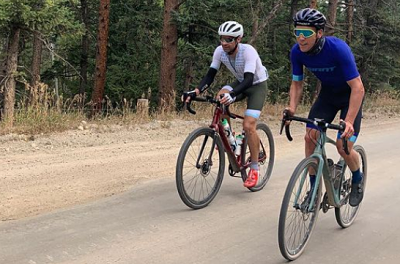Whilst 2020 and the lack of racing caused by the pandemic was a drag for many athletes, pro triathlete Sam Appleton used that time as an opportunity to add variety to his training by enjoying "soul filling" activities rather than chasing watts.
Sam hit his local Colorado trails on a gravel bike and rode for the love of it. Despite the less focused approach Sam found he still maintained a good level of fitness but had a renewed sense of mental freshness.
We caught up with the 15-time IRONMAN 70.3 winner to find out why he continues to include gravel riding as part of his training program...
Hey Sam, the pandemic obviously provided challenges for everyone but I understand it gave you an opportunity to mix up your training and get out on the trails. So, how much of your training time did you spend on your gravel bike?
I would say at least 50% of my total ride time in 2020 was on my gravel bike.
I actually only have a power meter on my TT bike, which sat dormant collecting dust for probably six months of the year. It was nice to just ride for the love of riding, and not be constantly involved with numbers and metrics.
Of course, when it came to getting serious for training in preparation for Challenge Daytona towards the back end of that year, my mindset shifted and I spent a lot more time on my TT bike, with my power meter holding me accountable.

So what was the major benefit of gravel riding for you?
Gravel riding where I'm based here in Colorado can be super hard if you go up into the mountains.
Often I would head out for 4 hours and only cover 70km because the terrain is so steep in certain aspects. I think this was great for some unstructured strength training, as I needed to push 350w (and more) for 10 minutes at a time just to get up some of the climbs (admittedly, I don't have a power meter on my gravel bike, but I know the power was roughly that high).
The major benefit was that I was still staying super fit on the bike, but not having that mental tax of structured workouts.
Taking into account what you learned from gravel riding, will you still be using more of these unstructured sessions in your training?
For sure. There's a time and place for gravel riding, and often when I'm just heading out for an endurance ride, I will choose the gravel bike.
It's quieter on the roads, and I enjoy it more than riding the TT all of the time.
It's important to ride the TT bike a lot though as the position is so different from a road or gravel bike, so you want to make sure your body is comfortable.
It's a balance for sure, but I will still ride the gravel bike at least one or two times per week going forward.
Do you do any other forms of cross-training?
In season, I don't do too much cross-training. I get in the gym a lot, but other than that I mainly stick to the three disciplines of swim, bike and run.
Sometimes when running, I will hit some trails and not worry about pace, which is a nice change-up.
With that focus on swim-bike-run in mind, what does a typical week of training look like for you when you're gearing up for a big race?
I'm definitely an athlete on the lower end of total volume in terms of hours.
My program is very much based on a certain number of key sessions per week, and then recovering from these sessions in time to go again.
Leading into my big race of 2020 - Challenge Daytona in November - I probably averaged 20-22 hours of training per week before tapering off.
My bigger training weeks usually consisted of:
- Swimming: 5-6 swims per week, totalling ~25km
- Cycling: Riding can vary from 250-500km per week, depending on what the target is for those 7 days. Generally, that includes two key bike rides and a long ride thrown in there as well.
- Running: I average anywhere from 40-70km. I do a lot of running off the bike, and most of my key bike sessions are followed by a race-specific run off.